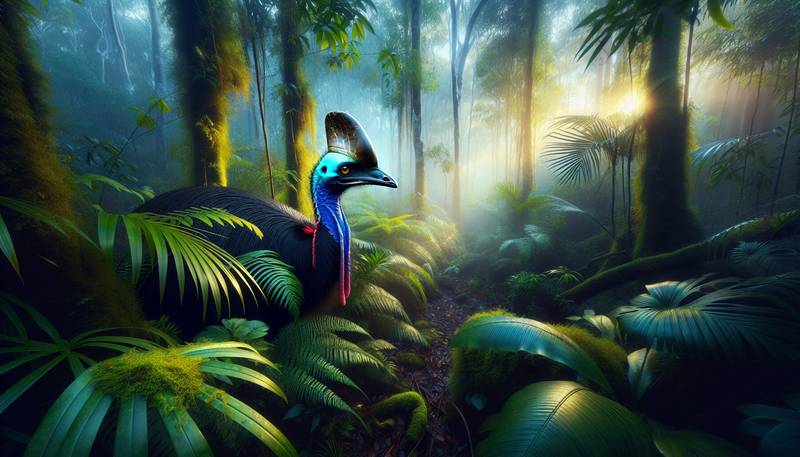Cassowary: Australia's Majestic Rainforest Dweller

Meet the CassowaryImagine a bird so large it could star in a superhero movie, complete with an impressive headpiece and a penchant for dramatic entrances. Enter the cassowary, an extraordinary creature that feels like it was designed by committee, with parts borrowed from an emu, a dinosaur, and perhaps a particularly avant-garde fashion designer. Renowned for its striking blue skin and a helmet-like casqued, this flightless wonder is not just a pretty face; it’s a vital part of Australia's rainforest ecosystem. Looks That Could KillThe cassowary's aesthetic could easily land it a spot on the cover of 'Rainforest Vogue. Sporting a blue neck and red wattle like a fashionable scarf, it strides through the jungle with all the grace of a runway model—if runway models had powerful legs capable of delivering a serious kick. Seriously, if you encounter one in the wild, remember: they’re not here for a social media photo op.Their intimidating stature—standing up to six feet tall—ensures they’re the center of attention wherever they go. Think of them as the gentle giants of the rainforest, unless you happen to step on their toes, then all bets are off! Diet and Dining HabitsNow, you might think a bird of such grandeur would have a taste reserved for only the finest of feathers and twigs, but cassowaries are more down-to-earth when it comes to dining. Their diet consists mainly of fruits, seeds, and fungi, showcasing a palate that can only be described as “exotic” by anyone who regularly eats grocery store bananas. These birds play an essential role in spreading seeds far and wide, thanks to their less-than-discerning digestion. Think of them as the rainforest’s own delivery service. Just as you sometimes discover surprises in your takeout bag, the rainforest gets its new plants thanks to the cassowary’s post-meal activities.Behavior and Social LifeLead a solitary life? So does the cassowary! These birds are like the introverts of the animal kingdom, preferring to keep to themselves rather than throw wild rainforest parties. While they may not be the most social creatures, their unique mating rituals are anything but dull. In typically understated fashion, male cassowaries will perform a dance that could rival the most extravagant wedding receptions—minus the “Chicken Dance,” of course.When it comes to parenting, however, males take the lead with all the enthusiasm of a new dad trying to assemble a crib without the instructions. They’ll incubate the eggs and raise the chicks with an overprotective flair that can only be described as a “don’t mess with my kids” mentality. Conservation StatusWhile cassowaries may have the flair of a celebrity, their status is anything but glamorous. Unfortunately, these magnificent birds are classified as vulnerable due to habitat loss, hunting, and the notorious “what’s that shiny thing?” syndrome that often afflicts birds. As humans encroach on their territory, cassowaries find themselves squeezed into smaller and smaller areas of rainforest, leading to increased risks of extinction. Efforts to save the cassowary are more important now than ever. Various conservation programs are underway to help protect their habitats and ensure future generations can experience the joy of seeing a cassowary in the wild, or at least on an educational wildlife documentary narrated by a soothing British voice. A Feathered FarewellIn a world where we sometimes forget the importance of our feathered friends, the cassowary reminds us that even the most unusual of creatures has a role to play. They may not be the cuddliest of pets, but these birds hold a special place in the ecosystem that is worth protecting. Next time you hear a weird sound or spot an oddly dressed bird, remember: it’s just the cassowary auditioning for its role in the next blockbuster film starring nature. So, let’s all give a round of applause—preferably from a safe distance!
|
|







